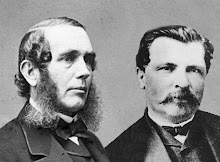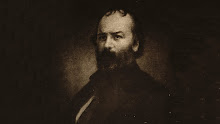After months of preparation, it's time to launch the documentary series! By that, I mean it's time to start writing the three half-hour episodes to be aired on PBS. With this much material, where to begin? That's my challenge. Fortunately, I created an outline of the three parts months ago and despite all that I've learned since then about Currier & Ives and 19th century America, it remains a good framework and a touchstone to which I will return time and time again.
Part 1 is called "Printmakers to the People" and will focus on the early years, turning points for the firm and personal insights into Currier & Ives.
Part 2 is titled "Cheap & Popular Pictures" and it will feature some of the most and least popular of the firm's output, as well as a closer look at the artists behind the firm and the passion of collectors today.
Part 3 is "The Surprise of Currier & Ives" and will give us the chance to examine the controversial and/or unusual lithographs that the firm produced throughout its long history.
Along the way, we'll see how the pictures made by Currier & Ives compare to what was really going on in the country, we'll contemplate whether the firm's prints reflected or projected an emerging American identity, if they can stand the test of time, and how these approximately 8,000 pictures launched the mass media that inundates us with thousands of images every day.
We do have a few shoots left, including an interview in WGBY's studios with Chris Lane of the Philadelphia Print Shop. You may recognize Chris from PBS' "Antiques Road Show". He, along with Robert Newman, is known as a top Currier & Ives expert and although the two men are competitors in the business world, they have graciously agreed to share the spotlight and spread the wealth of information for these documentaries. They've also been very generous in sharing rare images and records. We'll talk to Chris next week and later, catch him in action at the Historic Deerfield Antiques Show.
The first panel of animation for the series open is finished and it is just magical. Our appreciation to the talented folks at iMarc, who have shown so much enthusiasm for this job! They will also animate "The Awful Conflagration of the Steam Boat Lexington" and "Winter in the Country - A Cold Morning" for the open. The animators are most excited about "Lexington", with all its fire, smoke, and action. "Winter in the Morning" provides more subtle animation opportunities, such as snow falling, the man and dog walking, and smoke curling from the chimney.
I'm listening to online recordings of our narrator's voice to get it solidly in my ear and in my mind - in other words, to make sure that I capture that special Scott Simon quality while writing the narration for the series. I call it writing to voice. It's important in terms of both time and effort because it means that in the end, your narrator doesn't re-write your script so that he or she can read more comfortably and naturally.
That's it for now. Check the website over the next couple of weeks if you'd like information about our Teacher Workshop coming up in November, 2007.
Wednesday, September 26, 2007
Friday, September 7, 2007
Broaden the Impact, Deepen the Understanding
Sometimes it is tough for teachers to take on more. Many, especially in poorer cities, are pushed to their professional limits to meet the demands of the federal government, the state, parents, students and a host of others with opinions on how they might do their jobs better. I want to begin this blog by thanking the 35 Springfield teachers who enthusiastically "took on more" in our Currier & Ives Teacher Workshop at the Springfield Museum of Fine Art. In the end, we hope that by broadening the impact of the Currier and Ives collection at the Springfield Museums, we may ease teachers' workloads and deepen students' understanding of real American history.
"The Dark Side of Currier & Ives: Teacher Workshop" examined how the ideals of American democracy portrayed in Currier & Ives prints actually played out for those outside mainstream 19th century America: African Americans, Native Americans, women, and immigrants. This is an important discussion for teachers who are trying to convey the relevance of the collection to largely minority students! How can these children relate to these pictures and why should they care? What in the world do these scenes have to do with them, anyway?
Lecturers Dan Czitrom from Mount Holyoke College and James Smethurst of UMass provided context for the works and gave two views on the controversial topic of the Darktown Comic Series.
Teachers examined the works for themselves and learned about how they were made. They also enjoyed a behind-the-scenes look at how the curatorial staff preserves the prints.
In addition, teachers were introduced to Visual Thinking Strategies, a simple approach to analyzing images and a way to generate discussion with students using the prints as source material. VTL asks 3 simple questions: 1) What is going on in this picture? 2) What do you see that makes you say that? 3)What more can you find?
Patricia Johnson of Salem State College showed teachers how to explore ways that prints or other primary source materials can be used in the classroom as teaching tools.
Finally, I made a presentation of WGBY's short video previewing the upcoming documentaries and talked about some of what I've learned about the firm along the way. The biggest response during the video was a collective gasp when a collector revealed that someone recently paid $76,000 for a Currier & Ives print called "The American National Game of Baseball"!
I have read the teacher reviews of the workshop and they are glowing. The only consistent complaint was that the chairs were horribly uncomfortable. We look forward to another workshop in November and perhaps by then we'll have better chairs!
On the production front, the company iMarc presented a storyboard of its first animation for our series open and it looks great. They're animating "The Road-Winter" and when I found out they planned on making the horses move across the screen, I realized the animators needed to know that they are most likely trotters, which have a particular gait. Gail Cunard of the Harness Racing Museum and Hall of Fame quickly provided iMarc with slow-motion video of a trotting champion so that they can duplicate his movements in the animation. Fascinating stuff!
The crew shot this week at the Brimfield Antique Show. We captured the passion of the Currier & Ives collector by following John Zak on his treasure hunt. Zak is probably the premier Currier & Ives collector in the country, with a collection of thousands of prints that I have seen personally. It's amazing! What's more amazing is how fast one man on a mission can move through crowded fields of antiques. We had trouble keeping up! John didn't find the special large folio he'd hoped to find but he did manage to add 7 smaller prints to his collection. Most importantly, our audience will learn so much just by listening to his dialogue with the dealers about condition, margins, impression quality, and rarity. The man is an expert and a wonderful human being, to boot. He has been extraordinarily generous with his time and expertise throughout this project. Thanks, JohnZak!
That's all for now; I'll keep you posted.
"The Dark Side of Currier & Ives: Teacher Workshop" examined how the ideals of American democracy portrayed in Currier & Ives prints actually played out for those outside mainstream 19th century America: African Americans, Native Americans, women, and immigrants. This is an important discussion for teachers who are trying to convey the relevance of the collection to largely minority students! How can these children relate to these pictures and why should they care? What in the world do these scenes have to do with them, anyway?
Lecturers Dan Czitrom from Mount Holyoke College and James Smethurst of UMass provided context for the works and gave two views on the controversial topic of the Darktown Comic Series.
Teachers examined the works for themselves and learned about how they were made. They also enjoyed a behind-the-scenes look at how the curatorial staff preserves the prints.
In addition, teachers were introduced to Visual Thinking Strategies, a simple approach to analyzing images and a way to generate discussion with students using the prints as source material. VTL asks 3 simple questions: 1) What is going on in this picture? 2) What do you see that makes you say that? 3)What more can you find?
Patricia Johnson of Salem State College showed teachers how to explore ways that prints or other primary source materials can be used in the classroom as teaching tools.
Finally, I made a presentation of WGBY's short video previewing the upcoming documentaries and talked about some of what I've learned about the firm along the way. The biggest response during the video was a collective gasp when a collector revealed that someone recently paid $76,000 for a Currier & Ives print called "The American National Game of Baseball"!
I have read the teacher reviews of the workshop and they are glowing. The only consistent complaint was that the chairs were horribly uncomfortable. We look forward to another workshop in November and perhaps by then we'll have better chairs!
On the production front, the company iMarc presented a storyboard of its first animation for our series open and it looks great. They're animating "The Road-Winter" and when I found out they planned on making the horses move across the screen, I realized the animators needed to know that they are most likely trotters, which have a particular gait. Gail Cunard of the Harness Racing Museum and Hall of Fame quickly provided iMarc with slow-motion video of a trotting champion so that they can duplicate his movements in the animation. Fascinating stuff!
The crew shot this week at the Brimfield Antique Show. We captured the passion of the Currier & Ives collector by following John Zak on his treasure hunt. Zak is probably the premier Currier & Ives collector in the country, with a collection of thousands of prints that I have seen personally. It's amazing! What's more amazing is how fast one man on a mission can move through crowded fields of antiques. We had trouble keeping up! John didn't find the special large folio he'd hoped to find but he did manage to add 7 smaller prints to his collection. Most importantly, our audience will learn so much just by listening to his dialogue with the dealers about condition, margins, impression quality, and rarity. The man is an expert and a wonderful human being, to boot. He has been extraordinarily generous with his time and expertise throughout this project. Thanks, JohnZak!
That's all for now; I'll keep you posted.
Subscribe to:
Comments (Atom)

















